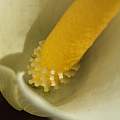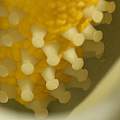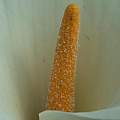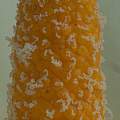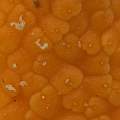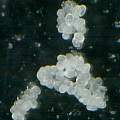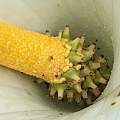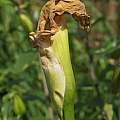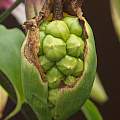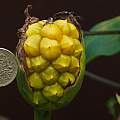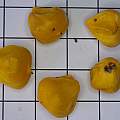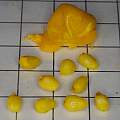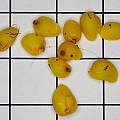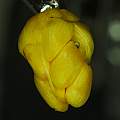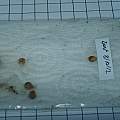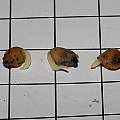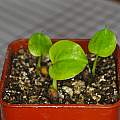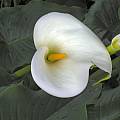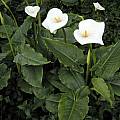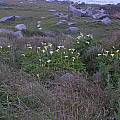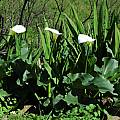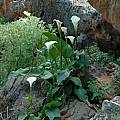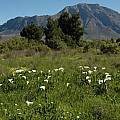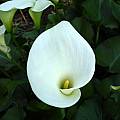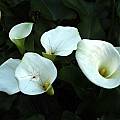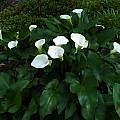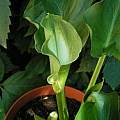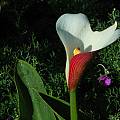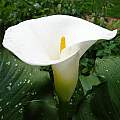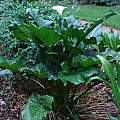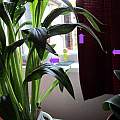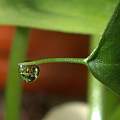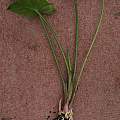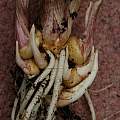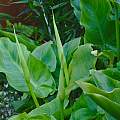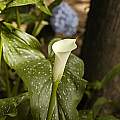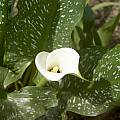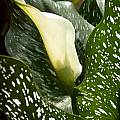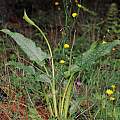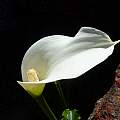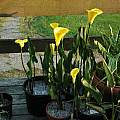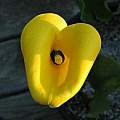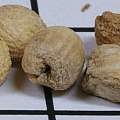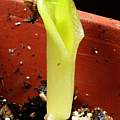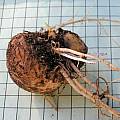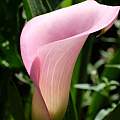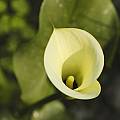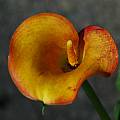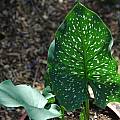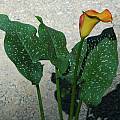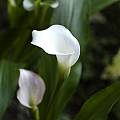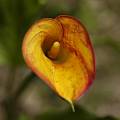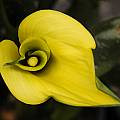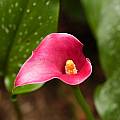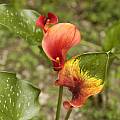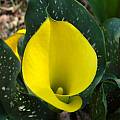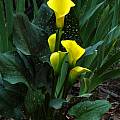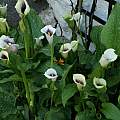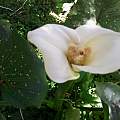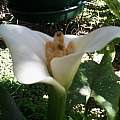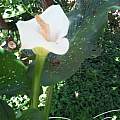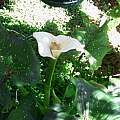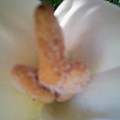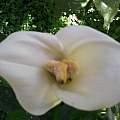Named after Giovanni Zantedeschi, Zantedeschia is a genus in the Araceae family from Southern Africa, Angola and Malawi of 8 species of rhizomatous deciduous or evergreen perennial herbs to 2.5 meters. Most are summer growing, but there are two species from the Cape Province of South Africa that are winter growing. There are also many colorful hybrids.
A Zantedeschia identification guide and growing tips was published by Veld & Flora magazine, and is reproduced here. Cameron McMaster has provided interesting information about this genus in an article he wrote for Farmer's Weekly in 2009.
The genus is monoecious with separate male and female flowers, which we here demonstrate on Zantedeschia aethiopica. Photos and text are from David Pilling. Height range: 2-3 ft. The first two photos show the base of the spadix; the white objects are female flowers (the genus is monoecious with separate male and female flowers). The white material near the top of the spadix is pollen which emerges from the male flowers and forms strings; the last photograph is about 0.5 mm wide. As the pollen is removed more appears to replace it. The pollen photos are of the same flower as the first two photos but a week later, showing how the spadix color changes.
When pollinated each of the female flowers will produce a seed pod; their development can be seen in the photographs. What looks like a large white petal is a bract (modified leaf); as the seeds develop it partially dies back and wraps around the seeds protecting them as captured in the second photo. The last two photos show the seed head ripening; the coin is around an inch in diameter.
Photos of seed pods, a seed pod and the seed it contained, and washed seed; all on a 10 mm grid. Fifty seed pods were produced from the seed head shown above. Photograph four shows how the seeds are packed in a seed pod.
Some of the seeds in the first three photographs above were put in a zip seal bag with moist kitchen paper on the 8th October 2012, kept at room temperature 65-70 °F and started to germinate on the 6th November; the final photo shows the seedlings in a 2" square pot on the 4th December.
Almost all the photos in this section are of the same flower stem; they cover a period from the first of June until the seeds were ripe at the start of October.
The time it takes to get a flowering plant from seed varies; with a sufficiently vigorous seedling in ideal conditions it is possible in as little as six months. Other specimens may take a few years. A factor is if the plants can be kept growing through the winter. Foliage is very sensitive to frost and will easily be killed and the roots can also be killed by frost.
Species
Zantedeschia aethiopica (L.) Spreng. is found in usually seasonally damp places in a wide range of the winter rainfall area. Known as Arum lilies or Calla lilies in different parts of the world, they are a popular cut flower which can be fragrant. In parts of Australia and New Zealand, this is a prohibited plant and considered a serious weed. This species has also naturalized along the Northern California coast and is found in many places, including abandoned homesteads, blooming in spring. Photos by Mary Sue Ittner show some of the naturalized plants including a clump at Salt Point State Park.
Habitat pictures taken by Mary Sue Ittner and Bob Rutemoeller near Brackenfell, in the Cederberg, and near Tulbagh 2006.
'Child's Perfection' (syn. 'Childsiana') is a dwarf selection of Zantedeschia aethiopica that grows to about 18 inches (0.5 m) tall in moist soil and partial shade. The arachnids on the flowers in the second photo are Opiliones, commonly called harvestmen or daddy-long-legs. Photos taken May 2007 by Jay Yourch.
'Green Goddess' is a variety with green tipped leaves. Photo from Janos Agoston.
'Rod's Red' is a selection from Rod Saunders in South Africa. Photo by Mary Sue Ittner.
'White Giant' is a huge selection of Zantedeschia aethiopica with spotted foliage up to about 48 inches (1.2 m) tall and flower spikes up to 72 inches (1.8 m) tall. Photos taken June 2009 by Jay Yourch.
Plants exhibit guttation. Guttation (from the latin gutta - speck, spot or drop) is the production of water droplets from plant leaves. First photo by Philip Turner shows a pot plant with droplets of water on its leaves; so much water was shed this way that he called it a "puddle plant" (it is probably 'Green Goddess'). Third photo by David Pilling of Zantedeschia aethiopica with water droplets on the ends of the leaves after four hours standing in a saucer of water.
The time lapse video by David Pilling shows a leaf tip of Zantedeschia aethiopica for about six hours (one frame every 50 seconds) after the plant was put in a pot of water.
Show video...
Photographs by David Pilling. The first two show the roots; it is easy to remove a section and grow a new plant. The last photo shows developing flowers.
Zantedeschia albomaculata (Hook.) Baill. is a summer rainfall species from eastern southern Africa found in marshy ground on rocky or grassy mountainsides. It is a medium/tall plant with arrow shaped leaves that often have white spots - the name means "spotted with white". It has white/creamy spathes, a few each year when young. It can be difficult to get a long enough growing season for flowering in cool climates. The first photo taken by Giorgio Pozzi June 2007 pictured below is a creamy spathe specimen growing in the wood with a hydrangea in background. Photos #2,3 were taken by Cameron McMaster. Photo #4 taken January 2010 by Bob Rutemoeller at Maclear.
Zantedeschia jucunda Letty is a yellow flowered species with white spotted green leaves endemic to the summit of the Leolo Mountains in northeast South Africa. It grows in sunny, rocky, rather arid north and west facing hillsides. This species depends on good rainfall in late November for good flowering. Since it flowers better with good light, it benefits from fires and grazing by livestock which keep the cover short. Seed germination is erratic, but best after successive days of cloudy, rainy weather.
Zantedeschia odorata P.L.Perry is endemic to the Bokkeveld Plateau where it grows in damp places in dolerite outcrops. It grows to 75 cm high and has arrow-like leaves. It can be distinguished from the other winter rainfall species, Zantedeschia aethiopica, by having a spathe that is scarcely flaring, a smaller spadix, and a fruiting peduncle that bends over. Flowers are very fragrant with a freesia like scent. Graham Duncan in Grow Bulbs comments that it "has very limited horticultural merit and is not more heavily scented than Zantedeschia aethiopica". This species is deciduous and flowers in habitat July-August. Photo taken in September 2011 near Nieuwoudtville by Cameron McMaster.
Zantedeschia pentlandii (R.Whyte ex W.Watson) Wittm. comes from the Mpumalanga and Limpopo provinces of South Africa where it grows in rocky places along mountain streams. The flowers are around 4 inches across and stand up to 29 inches tall. A common name is the 'Mapoch lily'. Flower photographs by Jim Shields, seedling and seed photographed on a 10 mm grid by David Pilling.
Zantedeschia rehmannii Engl. or the pink Arum is a deciduous species found in grassland and on rocky hillsides in the summer rainfall areas (KwaZulu-Natal, Swaziland). Both its spotless, elliptic leaves and its flowers are more slender than common hybrids. It blooms in summer. Photo by Mary Sue Ittner of a rhizome starting into growth (laid on a grid with 1 cm. squares). Pic 2 by Martin Bohnet shows the flower.
Hybrids and cultivars
Zantedeschia 'Black Magic' is a hybrid with light yellow flowers showing a black spot inside the spathe near the beginning of the spadix. Height: to about 2-2.5 ft. Photo by Giorgio Pozzi June 2007.
Zantedeschia 'Blaze' has bright orange flowers and large leaves with white spots. Height: to about 40 cm. Photos by Mary Sue Ittner show the flower and the leaf back lit and the whole plant.
Zantedeschia 'Cristal Blush' is a medium/tall plant with ice colour spathes, and long, narrow, plain green leaves. Height: to about 60 cm. The photo by Giorgio Pozzi was taken June 2007.
Zantedeschia 'Flame' is a medium/tall plant (60 cm), the spathes are yellow/orange with red stripes. The photo by Giorgio Pozzi was taken June 2007.
Zantedeschia 'Golden Chalice' is a hybrid from 'Callafornia Calla' nursery with many deep yellow spathes each year. It is a vigorous medium size plant that sets seeds. The picture shows the detail of a double spathe. Height: to 50 cm. The photo was taken June 2007 by Giorgio Pozzi.
Zantedeschia 'Majestic Red ' is a tall plant with red spathes and white spots on the leaves. Height: to 50 cm. The photo by Giorgio Pozzi was taken June/July 2007.
Zantedeschia 'Mango' is a medium/tall plant with variegated red orange spathes and leaves with white spots. Height: to 60 cm. The photo by Giorgio Pozzi was taken June 2007.
Zantedeschia 'Millennium Gold' (syn. 'Yellow Mammoth') is a hybrid with deep yellow flowers and spotted leaves. Height: to 60 cm. Photos were taken May 2007 by Jay Yourch.
Zantedeschia 'Picasso' is a medium sized plant with spotted leaves and white spathes fading to purple. It produces many spathes and offsets each year. Height: to 1 m. The first photo by Giorgio Pozzi was taken June 2007. David Pilling found a similar cultivar at the end of September in the Lake District at 500 feet, zone 7.
Zantedeschia is an unknown cultivar with an unusual double flower/triple spadix. It was photographed by Wilma Brand in Johannesburg, South Africa. For discussion see PBS list.
